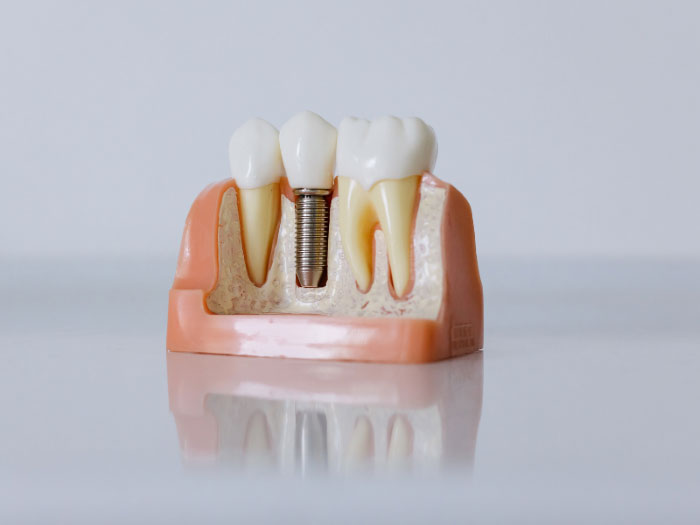The Ins & Outs of Implant Dentistry

Everyone wishes to retain their teeth forever, but diseases, environmental factors, and lifestyle have hindered this possibility. According to statistics, more than 7 million people have lost teeth either on the lower or upper jaw. Most of these people have dentures as a restorative treatment for their lost teeth or tooth.
Dentures are challenging to use and make it hard to chew food due to discomfort presented when worn. The good news though is you no longer have to put up with dentures any more dental implants will provide you with the comfort you deserve. Tooth loss is caused by several factors, and some are unavoidable while some can be prevented.
What Is a Dental Implant?
A dental implant is an artificial tooth root that is surgically inserted by a dental professional inside the gum in the jawbone. It acts as a support to a dental crown or denture. Dental implants have come a long way in their transformation of what they are today.
The Egyptians practiced implant dentistry as they used teeth from deceased people and shells to replace their lost teeth. They had the idea which was okay, but the materials they used were crude and caused infections. The method by which they used to implant crowns was also crude as they used to hammer the shells and teeth into the gums.
Researchers continued with their quest to find a material that was friendly and acceptable by the human body and finally titanium was the answer to the lengthy research. Dr. Branemark discovered that the bone could integrate with titanium making it durable and independent. He referred to the integration of bone and titanium as osseointegration. Dr. Branemark’s findings were further tested, and there was a tremendous success of 91% which has increased to 96% over the years.
Types Of Dental Implants
Dental implants are manufactured by many companies, and the models may differ from each other. It is recommended you have one dentist handle your dental implant because he/she understands the implant mounted on your jawbone and knows which type of crown or denture is compatible with it.
Dental implants are categorized in the relation of how they are mounted. There are two main categories of implant dentistry.
1. Endosteal
The implant which looks like a screw is inserted into the jawbone then the gum is put back on it allowing it to osseointegrate with the jawbone. Once the jawbone has fully integrated, the gum is opened to expose the upper part of the abutment and crown will be screwed. It is the commonly used method and suitable for patients with healthy bone mass.
2. Subperiosteal
The implant is placed just above or near the jawbone but not inserted into the bone. The upper part of the implant can be seen and fixing an abutment and crown is easier since you don’t need another surgery to expose the upper portion. It is the best type for those patients with less healthy bone mass, and who don’t want any augmentation of bone done on them.
How To Rebuild Bone Mass to Support the Implant
If you are one of the people who have unhealthy bone mass, the dentist will advise on a few procedures which you can choose to correct the anomaly. Here are some of them:
- Sinus augmentation. It is done by adding grafted bone under the sinus to fill up the bone that has worn out.
- Stimulation of bone growth and adding bone mass to correct lost bone mass.
- Some people have small jaws which hinder the implantation of dental implant and this type of scenario. Bone mass from grafted bone is added on a ridge or space at the upper part of the jaw.
Benefits of Dental Implants Over Other Procedures
- Dental implants are comfortable, and it is hard for a patient to tell the difference between the natural and the implanted tooth since you can chew and eat food with no obstruction.
- When a tooth is lost, stimulation of bone stops and bone mass decreases. Having an implant immediately a tooth is lost prevents bone wearing out.
- It is a lifetime procedure that doesn’t need changing every time. Due to its blending property with the bone, the implant becomes strong and permanent.
- It stabilizes the remaining teeth preventing them from moving and closing the gap formed by missing tooth. The shift made by teeth to close the gap affects the bite of an individual which eventually leads to health problems such as headaches and oral pain.
- When an implant replaces the lost tooth, it prevents residue foods and drinks from building up in the gap and attracting oral disease-causing microbes. Your oral health will be maintained, and you’ll be protected against gum diseases.
Dental implants can be the best treatment for your tooth loss, but it is crucial you have a dental practitioner who has a high success rate to avoid failure of implanting or incorrect implantation. With an experienced dentist, like Dr. Eric Yao in Shoreline, Washington, you are sure to have the best tooth replacement procedure. At the office of Dr. Yao, DDS, MAGD, LLSR, our implant services include sinus lift augmentation, autogenous bone grafting, implant site development, computer-enhanced treatment planning and implant maintenance. Contact our office today to learn more about dental implants and see if they’re the right choice for you!







